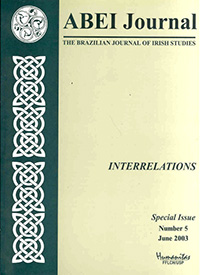Fatal Fathers and Sons in Tom Murphy’s A Whistle in the Dark
DOI:
https://doi.org/10.37389/abei.v5i1.182533Abstract
Under this general title I want to discuss several instances of “filicide” throughout twentieth century drama. As W.B. Yeats was a great advocate of the importance of the unconscious, I would start with Yeats’s idea of the father, as he goes from Cuchulainn’s slaughter of his son in On Baile’s Strand (1904) to that other infanticide (or rather adulticide) in Purgatory (1939), whereby his two Oedipus plays Sophocles’ King Oedipus (1928) and Sophocles’ Oedipus at Colonus (1934) yield important material to understand the complications inherent in father-son relations. Then I would move to Tom Murphy’s A Whistling in the Dark (1961), where the father has his rival son killed in more contemporary circumstances, to end with the very complex picture of the father-son relations Frank Mc Guinness offers in his Mutabilitie (1997), both in the colonist’s and the colonised households. I would hereby use a Lacanian approach, since this would allow for na in-depth analysis of the problems at stake. This approach, however, has already a respectable tradition, which means that the obvious works like Deleuze and Guattari’s L’anti-Oedipe, capitalisme et schizophrénie (1973) will first have to be nuanced by more recent studies like Philippe Julien’s Le manteau de Noé (1991). While the latter offers an excellent status quaestionis, this can be refined by remarks made by Didier Anzieu in his analysis of father-child relations in Créer détruire (1996), as well as by new representations of the concept of identity and desire by Philippe van Haute (Tegen de aanpassing, 2000).
References
em Shakespeare, William. Macbeth. (Ed.) Arden, Kenneth Muir. London: Methuen, 1997.
em Tom Murphy. A Whistle in the Dark and Other Plays. London: Methuen, 1989.
Downloads
Published
Issue
Section
License
Copyright (c) 2003 Hedwig Schwall

This work is licensed under a Creative Commons Attribution-NonCommercial 4.0 International License.


